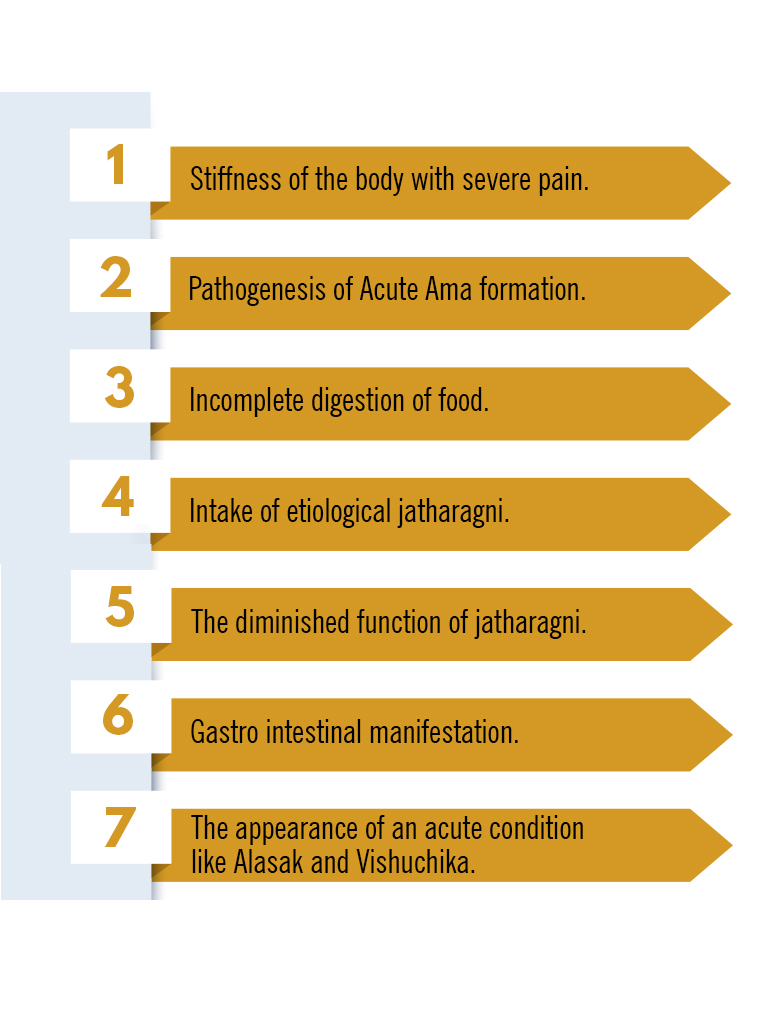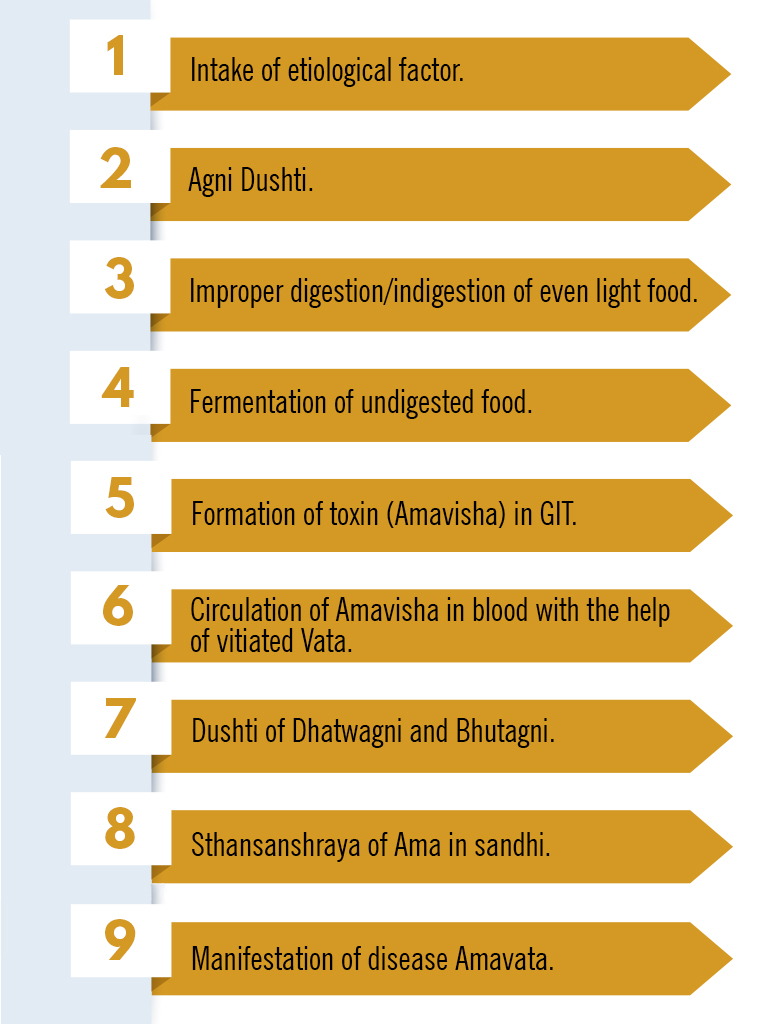Amavata (Rheumatoid arthritis) is an auto-immune disease where there is an aggravation of Vata dosha and storage of Ama in different joints of the body with significant inflammation and symmetrical polyarthritis. Ama results due to mandha agni of a patient. It is an undigested product that gets accumulated in body tissues and joints which leads to pain, stiffness and swelling, etc. Therefore Amavata initially starts as a gut disorder with symptoms of indigestion and loss of appetite which later on is seen to encroach all the tissues especially bones, muscles, joints, and multiple organs. Ama when formed goes into circulation in unprocessed form and gets metabolized and causes blockage of all the channels, which provide nutrition to the body. Hence multiple tissues are damaged and the manifestation of disease occurs. It is persistent inflammation that persists in synovial fluids in joints which further damaged the cartilage and bone of the joint.
Enhance your knowledge about the Amavata Ayurvedic treatment with this blog! Learn how Ayurveda works wonders for Rheumatoid arthritis.
Overview of Disease- Rheumatoid Arthritis (Amavata)
ऊष्मणोऽल्पबलत्वेन धातुमाद्यमपाचितम् । दुष्टमामाशयगतं रसमाम प्रचक्षते ।।
Rheumatoid arthritis is an auto-immune disorder that gets triggered by some infection and genetic pre-deposition. Joint involvement in rheumatoid arthritis is usually symmetrical with the presence of pain, swelling, tenderness, and restricted movement of joints. Modern science deals with this disease by using DMARD's , steroids, and NSAID but in Ayurveda, Amavata can be co-related with rheumatoid arthritis. It is a disease of Madhyam-Rogamarg. Asthi and Sandhi are chief sites where symptoms like sandhi shool, sandhi shoth, and sandhi graha occur. Food and eatables which are heavy to digest, indulgence in excessive sexual intercourse, getting nourished by tubers, leafy vegetables causes Ama and vitiated Vata leads to disturbance of Kapha producing pain and inflammation in the body, finally reaches to pitta causing a burning sensation in the body is actual pathogenesis of Amavata. Hence,
- Bahu Vedna- severe pain in body parts
- Amatisara- diarrhea or excessive unformed stool.
- Sandhi Shopha- swelling in joints.
- Jaratwam Gatranam- weakness in body parts.
- Balasa Patanama Mukhe- the expectation of saliva from the mouth.
- Prushta Manya Trika Vedana- pain in the back, neck, and pelvic region.
- Anga Vaikalya- physical deformities
All the above are significant symptoms seen in patients with Amavata.
Types of Rheumatoid Arthritis (Amavata)
Vishtambhi Amavata
Symptoms-
- Sharira Guruta- heaviness in the body.
- Adhmana- distention of abdomen.
- Vasti Shula- pain in the region of the urinary bladder.
Gulmi Amavata
Symptoms-
- Jatara Garjane- Various sounds produced in the abdomen.
- Gulmavata Pari pidyate- pain as in abdominal tumor.
- Katidesh Jadatvam- Stiffness in the pelvic region.
Snehi Amavata
Symptoms-
- Gatra, Snigethata- Feeling of oiliness of body.
- Jadhya- Stiffness of body parts.
- Mandagni- Low digestive fire.
- Snigdha Vijala Ama- Oil secretions over the body.
Pakva Amavata
Symptoms-
- Pita Vijala Shyava Pakwa ama Patate Adhah- Excretion of ama appears yellow or brown due to loss of wetness caused by decreased water content in the body.
- Navasti Shula- the absence of pain in the region of the urinary bladder.
- Shrama- Exhaustion
- Klama- Languor
Sarvanga Amavata
Symptoms-
- Kati Prushte Vaksho Deshe Rodonam- Pricking pain in the pelvis.
- Vasti Shula- pain in the region of the urinary bladder.
- Gulmato Jatharam Ggarjate- gurgling sounds in the abdomen as in abdominal tumors.
- Shopho- Swelling or inflammation of body parts.
- Shirogurutvam- The heaviness of head.
- Amascha Patati- Excretion of ama.
Causes of Rheumatoid Arthritis (Amavata)
Viruddha Ahara
Ahara Dravya which provokes dosha but cannot eliminate from the body is called Virudh Ahara. They are Dhatu-Shaithilyakara and dosha prakopar.
Types of Virudh Ahara are:
- Desh Viruddha- It is caused due to change in place.
- Kaal Viruddha- It is caused due to change in time.
- Agni Viruddha - It is caused due to change in digestion power.
- Matra Viruddha - It is caused due to change in dose.
- Satmya Viruddha - It is caused due to change in suitability.
- Dosh Viruddha - It is caused due to change against dosha.
- Sanskaar Viruddha - It is caused due to change in processing.
- Virya Viruddha - It is caused due to change in active principles.
- Kostha Viruddha - It is caused due to change in bowel movements.
- Avastha Viruddha - It is caused due to change in the state of health.
- Krama Viruddha - It is caused due to change in order.
- Parihara Viruddha - It is caused due changes in contraindications.
- Upachara Viruddha - It is caused due to change against prescription.
- Paka Viruddha - It is caused due to change caused due to uncooked food.
- Samyog Viruddha - It is caused due changes in mismatched combinations.
- Hrita Viruddha - It is caused due to change in palatability.
- Sampat Viruddha - It is caused due to change in the quality of food.
- Vidhi Viruddha - It is caused due to change in the rules of eating.
Viruddha Cheshta
It indicates all those activities of the body which harm the normal physiology of the body. Virudh Cheshta leads to vitiation of Agni hence producing Ama.
Following factors are responsible for dosha Utklesha:
Vega Udirana
Suppression of natural urge. There are 2 types of natural urges namely-
1. Dharaniya Vega- These are related to a mental status like- Lobha (greed), Shoka (grief), Bhaya (fear), Krodha(anger), Earshya (jealousy).
2. Adharaniya Vega- These are physical urges to be completed as and when they arise.
- Mutra vega- Suppression of urge of urination.
- Purisha vega- Suppression of urge of feces.
- Shukra vega- Suppression of urge of semen.
- Apana Vayu vega- Suppression of urge of passing flatus.
- Chardi vega- Suppression of urge of vomiting.
- Kshavathu vega- Suppression of urge of a sneeze.
- Udaggar vega- Suppression of urge of belching.
- Jrumbha vega- Suppression of urge of yawning.
- Kshudha vega- Suppression of urge of hunger.
- Trushna vega- Suppression of urge of thirst.
- Bashpa vega- Suppression of urge of crying.
- Nidra vega- Suppression of urge of sleep.
- Shram Ashwas vega- Suppression of urge of breathing heavily on exertion.
- Kasa vega- Suppression of urge of coughing.
- Anudirna vega Udirana-
- Diwaswapa- (day sleep) Sleep during day hours is known as Diwaswapa and it should be avoided.
- Ratri Jagrana- To have proper night sleep is essential because night awakening leads to an increase in Vata dosha. So night awakening causes body pain.
- Ati vyayama- Excessive exercise leads to muscular wear and tear and this lethargy of muscles leads to stiffness and pain in the body. Hence, restricted joint movements.
- Vishama Shayya Shayana – (uncomfortable sleep) There are several reasons for disturbed sleep i.e. too soft or too hard mattress, lack of space.
- Ativyavaya- Degenerative changes in bones also lead to pain and swelling in joints.
Mand Agni
It means the diminished function of Jatharagni, Dhatwagniand Bhutagni but it is possible that the function of Jatharagni is normal in patient and diminished Dhatwagni and Bhutagni leads to Ama formation which then gets circulated in blood with the help of Vata. Among the 3 types of Agni, Jathargani is very important. The strength of Jathargani indicates the healthiness of the digestive systems of the body.
Nischala
A person who is lazy and less active by nature is known as Nischala. Nutritious food leads to the accumulation of Kapha in the body. Sedentary habits vitiate Agni which in turn leads to vitiation of dosha and production of ama.
Exercise after Snigdha Ahara
Snigdha Ahara is a guru (heavy) which causes vitiation of Agni in the body and produces ama. Exercise after Snigh Ahara causes vitiation of Vayu and Kha- Vaigunya in joints. During exercise, there is excessive mobilization of joints. This overuse causes Kha-Vaigunya within them. Kha- Vaigunya with Snigdha Bhojana causes migration of dosha in joints. Hence Amavata.
Pathogenesis of Rheumatoid Arthritis (Ama Vata)
लंघनं स्वेदनं तिक्तं दीपनानि कटूनि च | विश्वनं स्नेहपानं बस्त्याश्चाममारुते ।।
सैन्धवाद्येनानुवास्य क्षारवस्ति: प्रशस्यते ।।
Ama which is formed in the body and Vata which gets vitiated pushes the ama to different parts through circulation mainly into Shleshma Sthana (sites of Kapha), bones joints, and muscles. This ama and Vata further disturb pitta which leads to disturbance of all Vata, Kapha, and pitta. Hence, a manifestation of a disease and their appearance of symptoms like:
Pathogenesis of Gradual Ama formation

Symptoms of Rheumatoid Arthritis (Amavata)
Initially, symptoms of Rheumatoid Arthritis are:
- Apaka (Indigestion): is seen and further disease when reaches to joints shows-
- Angamarda- Pain in the whole body.
- Aruchi- Loss of appetite.
- Trishna- Excessive thirst
- Alasya- Latharginess
- Gaurava- Heaviness in the body.
- Jwara- Fever
- Shunata- Swelling of body parts.
In later stages, when multiple tissues and organ damage occurs further symptoms are seen-
- Saruja Shopha- Painful swelling in hand, feet, knee, neck, ankle, wrist, and elbow.
- Vrishika Damshavat Peeda- Pain like Scorpion string.
- Agni Dourbalya- Sluggish digestion
- Praseka- Excessive salivation, nausea.
- Aruchi- Loss of appetite.
- Gouravam- Heaviness in the body.
- Vtsaha Hani- Lack of enthusiasm.
- Vair Asyam- Abnormal taste in the body.
- Daaha- Burning sensation.
- Bahu Mutrata- Excessive urination
- Grahani Dosha- Contamination of intestine.
- Apakwamala- When stool consists of undigested food.
- Kukshi Kathinata- Hardness of abdomen.
- Shulam- Colic pain
- Nidra Viparyaya- Sleep disturbance.
- Trishna- Thirst
- Chardi- Vomiting
- Bhrama- Giddiness
- Murcha- Faint
- Hrid Graham- Tightness in the chest
- Antra Kujana- Different sounds in the abdomen.
- Anaha- Flatulence.
Ayurvedic Management for Rheumatoid Arthritis (Amavata)
Langhana- In Yogaratnakara Langhana has been known best measure for the treatment of Ama (Rheumatoid Arthritis). Langhana in form of Laghu Ahar is prescribed. Amavata, considered as Amasayotha Vyadi and Rasaja Vikara can be easily treated by langhana.
Swedana- Swedana is indicated to relieve Stambha, Gaurava, and Shula in the body. Rukshasweda in form of Valukapottali is indicated due to the presence of Ama, it pacifies vitiated Vata and relieves pain and stiffness.
Tikta, Katu, Deepana- Improving digestion by using medicines that are bitter and pungent in taste. These drugs work as Amapachna hence help in relieving Shotha and Shola.
Virechana- In Amavata without any preoperative procedure Virechna is recommended directly. Purgation induced through anal route.
Vasti- Vasti is given medicines through the anal route. Specific medicated Bastis and oil basti is indicated in Amavata. Kshara basti and Anuvasana basti is done in amavata.
Shamanaushadi- Different medicines mentioned in the text to relieve different symptoms seen in Amavata are prescribed to the patient.
Shoola Shamanrtha- Shoola Shamanrtha i.e. to prescribe medicines that directly give relief to pain present in joints of the patient.
Rasaushadhi- In Ayurveda, some mineral compounds are used to treat Amavata to give speedy recovery to the patient.
External Treatments
Abyanga- Massage of various parts of the body to give relief to Rukshaguna of Vata, different oil application to body parts is done.
Swedana- Steaming treatments to give relief to Sheetaguna of Vata, hot fomentation is recommended in Amavata. This also increases the circulation of blood to the joint and relief to muscular rigidity.
Pinda Sweda- Especially Churna pinda, sweda, Patra pinda sweda. Swedna to localized part or generalized part reliefs body pains, restricted movements and finally balances Vata dosha in the body.
Baluka Sweda- Baluka (sand) Sweda (hot formentation). A little quantity of sand along with Ajmod, Turmeric, Sendha Namak (salt) is warm and rolled over the affected joint to get relief from inflammation and pain in it.
Dhara- Pouring of medicated liquids, mainly Dhanyamla Dhara. Rheumatoid arthritis is usually associated with anxiety and depression. Hence, pouring medicated liquid over the forehead gives relaxation to the mind.
Upanaha- Poultice (lep) Medicated paste is prepared to be applied over joints affected in Amavata which also relieves inflammation present in joints.
Role of Diet in Treating Rheumatoid Arthritis (Amavata)
यवाः कुलत्थाः श्यामाकाः कोद्रवा रक्तशालयः। वास्तुकं शिग्रु वर्षाभूः कारवेल्लं पटोलकम्॥
आर्द्रकं तप्तनीरं च लशुनं तकसंस्कृतम्।। जागलाना तथा मांस स आमवात गदे हितम्॥
In Ayurveda, diet is prescribed according to an imbalance of Vata, Pitta and Kapha. So, recommended diet for rheumatoid arthritis or Amavata needs to pacify or balance Vata. Food to be consumed includes grains that could be easily digested, Legums, lukewarm water or water boiled in ginger root, green leafy vegetables, spices like ginger, turmeric, garlic due to their anti-inflammatory properties.
|
Pathya (What to eat) |
Apathya (What not to eat) |
||
| 1 |
Barley |
Curd |
|
| 2 |
Horse gram |
Jaggery |
|
| 3 |
Red rice |
Wheat |
|
| 4 |
Paspalum |
Milk |
|
| 5 |
Millets |
Flour prepared from black gram |
|
| 6 |
Rice grass |
Wind blowing areas |
|
| 7 |
Cow grass |
Wrong food combinations |
|
| 8 |
Drumsticks |
Controlling natural body urges |
|
| 9 |
Pointed gourd |
Habit of staying awake the whole night |
|
| 10 |
Bitter gourd |
Food heavy to digest |
|
| 11 |
Ginger |
Food sour in taste |
|
| 12 |
Punarnava |
Cheese |
|
| 13 |
Garlic is processed in buttermilk |
|
Exercises
Rheumatoid arthritis is a disease in which a patient suffers from joint ache and hence leads to restricted movement of the body due to morning stiffness and pain. So exercise holds a big deal in rheumatoid arthritis. To be physically active, doing exercises to restore joint movements and improve mobility of joints, the right type of exercise is recommended.
- Trikonasana
- Shalabhasana
- Vakrasana
- Padmasana
- Meditation for 20 minutes at least.
- Mobilization of small joints with light frequency. There should be no extra pressure put on them.
- Pranayama
- Anulom-Vilom
- Kapalabhati
- Light walk
- Sun bathing for 1 hour
Conclusion
Rheumatoid arthritis is a serious auto-immune disease that leads to severe pain and inflammation in various joints of the body. If it is not treated with the correct treatment according to the body type it can even lead to deformity of hands and feet. In this article, you will get to know about Rheumatoid Arthritis (Amavata) treatment in Ayurveda its causes, symptoms and, its Ayurvedic management.
*Do not forget to consult your specialist before beginning any tips or home remedies as every individual has a different body type so it is not always possible that any tips or remedies can suit everyone. So consult an expert and then only begin as guided by them.
